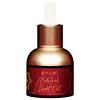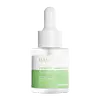What's inside
What's inside
 Key Ingredients
Key Ingredients

 Benefits
Benefits

 Concerns
Concerns

No concerns
 Ingredients Side-by-side
Ingredients Side-by-side

Punica Granatum Seed Oil
EmollientSimmondsia Chinensis Seed Oil
EmollientPolysorbate 20
EmulsifyingSorbitan Oleate
EmulsifyingPsoralea Corylifolia Seed Extract
Skin ConditioningPhenoxyethanol
PreservativeLactobionic Acid
BufferingRosa Rugosa Flower Oil
MaskingCitrus Paradisi Peel Oil
MaskingHelianthus Annuus Seed Oil
EmollientTriticum Vulgare Germ Oil
EmollientPrunus Amygdalus Dulcis Oil
Skin ConditioningCitrus Aurantium Flower Oil
PerfumingCalophyllum Inophyllum Seed Oil
AntimicrobialHippophae Rhamnoides Oil
EmollientBHT
AntioxidantPunica Granatum Seed Oil, Simmondsia Chinensis Seed Oil, Polysorbate 20, Sorbitan Oleate, Psoralea Corylifolia Seed Extract, Phenoxyethanol, Lactobionic Acid, Rosa Rugosa Flower Oil, Citrus Paradisi Peel Oil, Helianthus Annuus Seed Oil, Triticum Vulgare Germ Oil, Prunus Amygdalus Dulcis Oil, Citrus Aurantium Flower Oil, Calophyllum Inophyllum Seed Oil, Hippophae Rhamnoides Oil, BHT
Water
Skin ConditioningBetaine
HumectantDicaprylyl Carbonate
EmollientMethyl Gluceth-20
HumectantNeopentyl Glycol Diheptanoate
EmollientNiacinamide
SmoothingPropanediol
SolventGlycerin
HumectantEthoxydiglycol
HumectantZinc PCA
HumectantPhenoxyethanol
PreservativeButylene Glycol
HumectantBakuchiol
AntimicrobialHelianthus Annuus Seed Oil
EmollientHydroxyethyl Acrylate/Sodium Acryloyldimethyl Taurate Copolymer
Emulsion StabilisingCarbomer
Emulsion StabilisingAllantoin
Skin ConditioningEthylhexylglycerin
Skin ConditioningDisodium EDTA
Inositol
HumectantTocopheryl Acetate
AntioxidantTriethanolamine
BufferingSodium Hyaluronate
HumectantPolysorbate 20
EmulsifyingPalmitoyl Tripeptide-1
Skin ConditioningPalmitoyl Tetrapeptide-7
Skin ConditioningWater, Betaine, Dicaprylyl Carbonate, Methyl Gluceth-20, Neopentyl Glycol Diheptanoate, Niacinamide, Propanediol, Glycerin, Ethoxydiglycol, Zinc PCA, Phenoxyethanol, Butylene Glycol, Bakuchiol, Helianthus Annuus Seed Oil, Hydroxyethyl Acrylate/Sodium Acryloyldimethyl Taurate Copolymer, Carbomer, Allantoin, Ethylhexylglycerin, Disodium EDTA, Inositol, Tocopheryl Acetate, Triethanolamine, Sodium Hyaluronate, Polysorbate 20, Palmitoyl Tripeptide-1, Palmitoyl Tetrapeptide-7
Alternatives
Ingredients Explained
These ingredients are found in both products.
Ingredients higher up in an ingredient list are typically present in a larger amount.
Helianthus Annuus Seed Oil is the oil derived from the seeds of a Sunflower. Sunflower seed oil is non-fragrant. It is an emollient, meaning it helps to soften the skin.
Sunflower seed oil contains many fatty acids. The fatty acids found in sunflower seeds include (from highest amount to least): linoleic acid, myristic acid, palmitic acid, stearic acid, arachidic acid, oleic acid, and linolenic acid.
These fatty acids help the skin create ceramides. Ceramides play a role in repairing the skin barrier.
Helianthus Annuus Seed Oil helps moisturize the skin. This in turn helps the skin look more rejuvenated and smoother.
Sunflowers are rich in vitamin E.
Historians believe Indigenous cultures of North America domesticated sunflowers before corn. Thus they relied on sunflower oil for a variety of uses. One such use is moisturizing skin and hair.
Sunflower seed oil may not be fungal acne safe. We recommend speaking with a professional if you have any concerns.
Learn more about Helianthus Annuus Seed OilPhenoxyethanol is a preservative that has germicide, antimicrobial, and aromatic properties. Studies show that phenoxyethanol can prevent microbial growth. By itself, it has a scent that is similar to that of a rose.
It's often used in formulations along with Caprylyl Glycol to preserve the shelf life of products.
Polysorbate 20 is made by combining ethoxylation of sorbitan, ethylene oxide, and lauric acid. It is a mild cleansing agent, surfactant, and emulsifier.
As a surfactant, it helps collect dirt and oils for washing. Emulsifiers prevent oils and water from separating.
Polysorbate 20 also adds scent to a product. Since it is made using sorbitol, it has a sweet scent. Sorbitol can also be found in fruits such as apples and peaches.
The lauric acid used to create Polysorbate 20 is often derived from coconuts.
Polysorbate 20 may not be fungal acne safe.
Learn more about Polysorbate 20